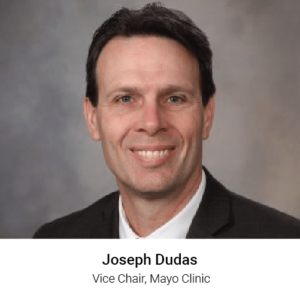 Improvement in our health system is sorely needed and analytics may be one of our biggest opportunities to shape the future. Other industries have leveraged sophisticated data tools and techniques to not only improve but completely disrupt standards and best practices. Modernizing clinical registries may be the most likely place to start as this long standing instrument has bridged information gaps across providers for many years. With registries we can quickly channel new technology innovations to narrow cohorts of patient data in a step-wise manner and make medicine more efficient, effective and precise. Perhaps we can even disrupt a few long standing “best practices” along the way.
Improvement in our health system is sorely needed and analytics may be one of our biggest opportunities to shape the future. Other industries have leveraged sophisticated data tools and techniques to not only improve but completely disrupt standards and best practices. Modernizing clinical registries may be the most likely place to start as this long standing instrument has bridged information gaps across providers for many years. With registries we can quickly channel new technology innovations to narrow cohorts of patient data in a step-wise manner and make medicine more efficient, effective and precise. Perhaps we can even disrupt a few long standing “best practices” along the way.
Why Analytics are needed.
In two past articles, I provided a background in both Healthcare Analytics as well as Electronic Medical Records. (Source: Dudas) Great progress has been made, thanks to the CMS Meaningful Use program, as well as the significant investments by investors in Healthcare Analytics. However, progress is not coming fast enough. The cost and quality of Healthcare today has likely changed little in the last 18-24 months. We are seeing daily headlines pertaining to the ACA and a lot of questions as to whether we are heading down the right track. While I am not going to chose sides, it is likely not the payer or regulator that is going to change healthcare but instead the healthcare providers and their patients. This is where “precision medicine” comes in. Precision medicine embraces care that is tailored to individual needs. While there is proven to be waste associated with variability, one could argue that there is even more waste in imprecise medicine (mainly due to a lack of data and analytics at the point of care that is targeted to individual patients). Let’s examine a very basic example, blood pressure.
Your blood pressure (BP) rises with each heartbeat and falls when your heart relaxes between beats. While BP can change from minute to minute with changes in posture, exercise, stress or sleep, it should normally be less than 120/80. About one in three U.S. adults, according to this standard, has high blood pressure. (Source: AHA),
Logically, many are challenged to understand this long standing best practice. How can a system as complex as the human body and as varied, by the genome, hold to such a basic guideline? It just defies what we would expect. In fact, many physicians and researchers do not agree with this standard. One recent article professes that millions of people, that have been told they are on the path to hypertension, may never develop life-threatening problems. According to new research, some suggest it’s time to redefine “normal” blood pressure. Findings, from researchers at the Veterans Affairs Health Care System in Minneapolis and the University of Minnesota, suggest that as many as 100 million Americans who have been told they have a condition called prehypertension may face no added mortality risk. They could reasonably be considered to have normal blood pressure. (Source: Parker-Pope)
It is not the intent of this article to truly interpret these findings; however, as an example it just seems to make sense that other factors could be considered prior to coming to a diagnostic conclusion as important as this one. What if those that question the standard are right? Total estimated costs associated with high blood pressure in 2011 in the US were $46 billion. (Source: CDC). This is why we need analytics and why we need them now. It is not to imply that standards or care pathways are not useful but instead they are only truly optimized at the point of care when coupled with meaningful data as well as physician and patient insight and judgment.
The role of clinical registries.
A possible strategy to closing the analytics gap may be a renewed investment in what could be called “modern day registries”. Historically, cohort specific patient registries have been collected to reference an individual’s medical history. This has allowed clinicians and researchers to more accurately understand the prevalence of a disease, associated therapies and outcomes. This information has then been used to give more accurate advice to patients and improves care pathways; ultimately improving care, even in the absence of a cure.
Unfortunately there are few if any solutions available on the market place today that are scalable enough to provide the type of information needed for precision medicine. In fact, Health Leaders recently stated the following in their publication:
“Of the clinical registries that exist in the United States, only a handful is up to snuff, and a lot of care isn’t being tracked at all, according to a study published in the Journal for Healthcare Quality. It not only found that most U.S. clinical registries that collect data on patient outcomes are substandard, but also that the vast majority of recognized medical specialties in the United States have no national clinical registry.” (Source: Pecci)
So why suggest that registries could be the answer? Registries provide us a way to focus recent technology advancements. New IT innovation can be applied in a very practical manner to rapidly close the scalability gaps of the past while not getting lost in the magnitude of our vast and complex healthcare system. One of the biggest issues with registries of the past is that they are mainly point in time collections of manually entered data (a significantly limited view from both a timeframe perspective as well as data granularity). However, when brought up to modern technical capability they provide new levels of scale and sophistication.
For example, a new set of standards called FHIR (fast healthcare interoperable resources) can be used to automate manual tasks such as the updating beyond a single point in time to a longitudal patient view (over years as oppose to days). This could provide insights into meaningful and long term benefits as well as detriments associated with treatment. FHIR is currently under development by the HL7 (healthcare level 7) group who currently maintains the most widely used healthcare interfacing standards today. FHIR takes HL7 to the next level by not only creating a common and extensible structure but also provides a real-time application interface. (Source: HL7 International) This is the same type of interface that is used to rapidly deploy and reuse internet functionality like PayPal.
The other area of development that can be leveraged is what is called “Big Data”. Big data is generally a set of database and query technologies that were designed by Internet innovators such as Google. Google and others quickly grew frustrated with traditional database technology as the web grew in both size and complexity. As a result, they invented their own data management solutions (which are now available through commercial entities such as Hadoop). (Source: Arthur) This is mainly how and why search works. This technology can be used in a very practical manner to quickly extract unstructured information from the electronic medical record (EMR) the same way Pandora can parse the lyrics of a song. This is important as much of the meaningful and detailed information needed to power precision medicine lies within the notes section of the EMR. This is how we solve the granularity problem.
While there are other benefits (for example, use of data outside of EMR) that I will not go into, I think you can see how we can overcome past limitations. I know this to be possible because I have been personally engaged in a very similar project albeit for only one healthcare system.
Potential benefits.
Modern registries can be used to solve all sorts of problems. For example, the FDA would love to have a reliable surveillance system in place. Such a system could proactively monitor new medicines and devices to detect adverse events. Today they do not have such a system so they rely on very expensive and time constraining clinical trials. This is why many new therapies are introduced outside of the United States (because other regions have a lower risk tolerance). I actually applaud the FDA for maintaining a higher standard. The reason, we don’t have to give up safety we just need to be smarter about our safety systems.
While surveillance by itself would make a strong use case for these new registries (coupled with the latest technology) the real value is in enabling care delivery that is far more precise. The Institute of Medicine (IOM) sponsored the writing of a 500+ page document on the difficulties surrounding diagnostic accuracy.
“This difficulty in identifying the etiology of errors, combined with a lack of feedback on diagnostic performance in many health care settings, limits understanding and makes it more difficult to prioritize improving diagnosis and reducing diagnostic errors.” (Source: IOM)
Registries could certainly be scaled so that key patient characteristics could be compared when determining health problems thus individualizing our diagnostic systems. Additionally, this same information could be used to tailor treatment that is far more effective and efficient for these same patients. For example, genomic information can be used to determine optimal drug choice and dosing based on the individual as opposed to broad populations. We can even start understanding value beyond a single point in time or narrow window such as some of the common 30 day metrics used today.
All these advantages could be leveraged not just by one system but across many through the use of common and open interfaces mentioned previously (FHIR).
Closing.
It is clear that traditional technology is not enough and we have to learn how to leverage the latest innovations in analytics. While registries will not provide a silver bullet strategy, registries gives us the ability to practically focus technology. There is obviously no substitute for clinical talent nor patient self advocacy and engagement, but we can optimize performance by providing modern clinical registries that scale. These new analytic tools can surface the insights providers and patients really need and thus enable precise decision making.















